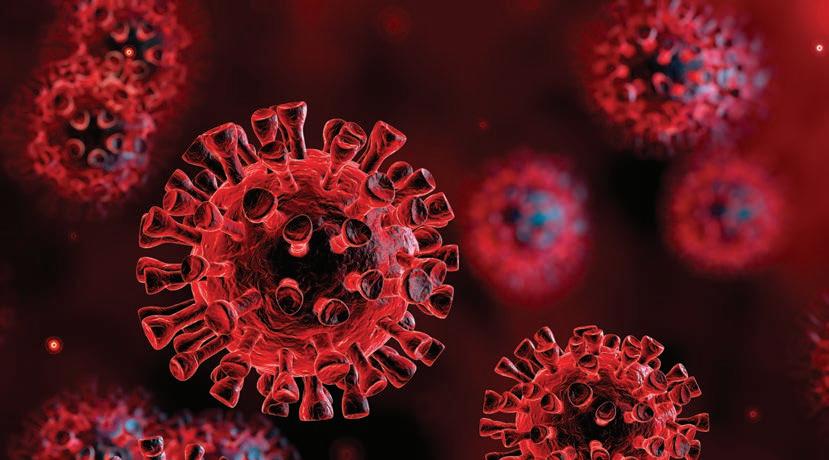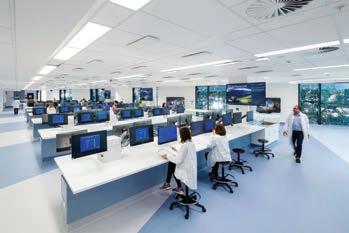
7 minute read
What ar e ‘Superlabs’? And what makes for a superbly designed Superlabs?
What are ‘Superlabs’? And what makes for a superbly designed Superlabs?
Graeme Spencer I Director of Education, Science and Technology
Imagine dozens of brilliant scientists and scientists-to-be working side by side in one large, open and fully equipped lab space — a shared space humming with the activity of curious minds as they interact with, learn from and inspire one another. I would describe such a setting as nothing short of super. In fact, as many in the industry know, laboratory facilities that facilitate learning/teaching and the exchange of ideas in a large group environment, as well as potentially running multiple sessions in parallel, are often referred to as ‘Superlabs’.
Established in 2006, the London Metropolitan University’s Science Centre is home to one such Superlabs. At 280 individual workstations, this Superlabs is not only considered one of the largest and most advanced educational science facilities in Europe, but is also often credited as being the first open-plan Superlabs in the world to enable scientific research and learning to be carried out simultaneously at such a scale.
HDR is currently working on a number of Superlabs, which while not necessarily an entirely new concept, do constantly offer interesting opportunities to explore and compare teaching pedagogies. The value of such opportunities are reflected in the Australian university sector’s increasing interest in and demand for the benefits of the Superlabs.
So what is the major benefit that Superlabs have to offer?
Efficiency
From an academic standpoint incorporating Superlabs teaching space provides the duality of increasing efficiencies and mimicking the real world environment, as institutions and corporations move to larger open spaces with transparency to the workspace beyond, this environment helps students become better prepared for their future.
The multidiscipline academic programs contained within a singular open plan learning environment, hum with the activity of curious minds as they interact with, learn from and inspire one another. With a constrained site and floor plate the Superlabs create huge teaching efficiencies due to its contiguous space, comparative to a cellular traditional teaching lab planning approach. Superlabs more efficiently utilise real estate and support a larger ‘teaching and support’ head count, both of which help maximize cost efficiencies. Design of Superlabs are standardised to provide flexibility in science pedagogies, easily taking the labs from physics to chemistry to biomedicine and more. This allows University to collocate multiple science departments, and also provides for responsiveness to changes in the education program, both of which help maximise cost efficiencies in a very competitive university sector.
But while the flexibility of having larger numbers of students sharing a space at any given time may be economically appealing, it won’t count for much if the quality of teaching
is adversely affected. As a former biologist myself, I can attest — based on my own days as an undergraduate in a biology practical — that a quality teaching process is key to knowledge retention and to making the journey of learning and discovery more enjoyable and exciting. I would also argue that the camaraderie developed between students is an equally valuable life skill for life beyond graduation.
The question, therefore, is this: What factors should design teams address to ensure high levels of teaching quality in Superlabs? To answer that, we have created a Superlabs design quality checklist to prompt some thoughts at the initial stage.
Technology
Our design thinking has accommodated for evolving patterns of use while considering the type of laboratory — from physics, to chemistry or microbiology. For example, mounted computer screens is a critical challenge because technologies evolve at rates that are far faster than that of a large construction project, hence the importance of seeking qualified expertise and establishing suitable budgets. It is important to determine how students will use this space. We live in a ‘bring your own device’ era; electronic lab notebooks (ELN), tablets and hybrid devices are becoming increasingly common; and apps have become part of the teaching process. Design thinking has to accommodate for evolving patterns of use while considering the type of laboratory — from computer or engineering to, for instance, chemistry or microbiology. For example, bracket mounts cannot be an afterthought and have to be carefully planned out as part of the overall design of the space. The opportunity of running several lessons simultaneously in the same space can only work with the right technology in place and operational. Monitor bracket mounts clear work surfaces and improve safety.
Acoustics
Noise is such a variable factor — the right amount of ‘good’ background noise can have a calming and comforting effect while stark silence can actually be quite confronting in a stressful environment. A ‘sound’ design (pun intended) considers the use of technology to address auditory quality
that goes beyond volume control, for example through the use of directional speakers or more personal solutions such as headsets. Furthermore, when all is said and done, it is the architects’ and engineers’ responsibility to ensure the spaces are compliant with all accreditation requirements and that the available materials and finishes have been utilised in the best manner possible. The evolution of the Superlabs from the London Metro headset, to the use of active directional white noise speakers to create ‘cones of silence’ around each station at University of Sydney’s Life, Earth and Environmental Science building, to the UTS Hive Lab incorporation of bone conducting headsets, allow the opportunity of running several lessons simultaneously with little disruption between classes.
Sharing equipment and resources benefit an institution's bottom line.
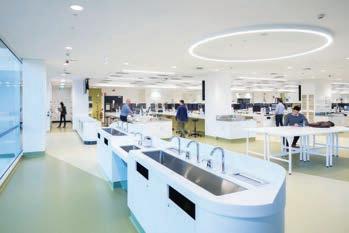
Equipment
One of the biggest benefits of Superlabs, again from an efficiency perspective, is the possibility of sharing equipment and making valuable inventory readily accessible. Secondary benefits related to equipment in a large, open laboratory environment include more efficient troubleshooting and improved repair and maintenance operations that can positively impact operational expenditures. A Superlabs environment provides staff with increased opportunities to monitor students and educate them on the use of equipment. In the case of microbiology, for instance, it is essential that students learn about the principles underlying a sterile workplace, equipment and technique, since cell culture
Circulation and access to exits are important layout considerations.
experiments are ruined once contaminated.
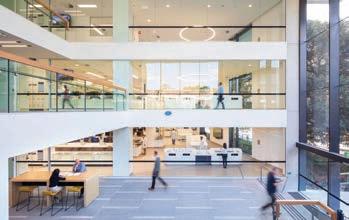
Spatial Allowance
Safety in a laboratory setting is fundamental. Plenty of planning references and code requirements that influence lab planning and design address all issues from bench spacing to entrances and exits. Efficiency is by definition a key driver of Superlabs planning. That being said, a good layout will both maximise efficiency yet retain all aspects of sensible planning and rational layout of fixed items while allowing flexibility around loose items and equipment.

Generous circulation spaces make it easier for large groups of students to enter and depart.
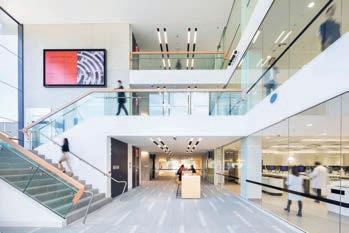
Spatial Allocation
While the Superlabs have significantly increased timetabling efficiency and throughput of undergraduate teaching lab courses, significant feedback from staff is the improvement of teachers and tutors increased opportunities to monitor students and educate them on the use of equipment and experimental procedures. In the case of the microbiology course, for instance, it is essential that students learn about the principles underlying a sterile workplace, equipment and technique, since cell culture experiments are ruined once contaminated. This has dramatically decreased in the new open plan laboratory environment.
One of the operational challenges facing Superlabs design is managing the pedestrian movement of student arrivals and departures between classes — where the student population per lab of 200 students is of course far greater than in a traditional teaching laboratory. Integrated AV technology that clearly identifies and driects students’ bench locations, such as large format wayfinding signage displays and indicator lights at bench stations, is of the utmost importance, especially when several activities are being held simultaneously. Working closely with the timetabling group, class period scheduling was coordinated to provide seamless access to student protective safety equipment and pick up/drop off lockers.
Large windows can improve lighting levels while providing a better backdrop.
Environmental Quality and Quality of the Environment
Students deserve environments that encourage the exchange of ideas, promote a desire to learn, and that simply make them want to be there. The environment should aspire to improve on the limited palette and dreary backdrops typically associated with traditional laboratories. There are no excuses for a boring teaching environments and a dynamic interior design should inspired by the surrounding landscape by responding to this challenge in providing a highly engaging teaching environment.
Superlabs afford a wonderful opportunity to enhance educational and research objectives, through transparency of these spaces. By allowing students who are coming and going to peer into teaching and learning environments, truly places science on display and visually reinforces the accessibility of teaching staff and the state of the art lab environments, demonstrates a university’s commitment to providing exceptional learning experiences.
About the Author
Graeme Spencer
Graeme has 25 years of practice experience with international design firms. His work spans a variety of architectural settings, including heading the design and execution of education, advanced research, healthcare, major infrastructure, arts and cultural projects in the United Kingdom, Middle East and most recently Australasia. In addition to leading various projects, Graeme spearheads HDR’s efforts in Data Driven Design for strategic campus master planning.








